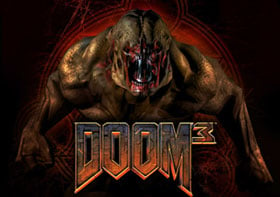Next Generation Gaming Performance Analysis - A Doom 3 and Counter Strike Source Drag Race
Test System and Doom 3 IQ Quick Take
Well then, we might as well dig right into testing here and as such we'll detail quickly for you our systems specifications below. An obvious notable are the graphics drivers we used for testing in this article. Specifically we used NVIDIA's publicly available and released 61.77 version Forceware drivers for the GeForce 6800 Ultra card we tested. For the ATi Radeon X800 XT PE, we chose ATi's also publicly available but in beta form Catalyst 4.9 drivers. These have a Doom 3 "hotfix" incorporated, which corrected a few bugs in Doom 3 for Radeons and is also optimized for performance a bit more with Id's new horrific first person shooter. The rest of our setup is all common identical hardware, since we simply swapped out graphics cards in the same test bed, for all benchmark runs.
|
| Hardware: Motherboard - Video Cards - Memory - Audio - Hard Drive - Optical Drive - Other - Software: Operating System - Chipset Drivers - DirectX - Video Drivers - |
Intel Abit IC7-MAX 3 Motherboard i875P "Canterwood" Chipset ATi Radeon X800 XT NVIDIA GeForce 6800 Ultra 2048MB Kingston HyperX PC3500 CAS 2 Sound Blaster Audigy 2 ZS 2 Western Digital "Raptor" 74GB - 10,000RPM - RAID 0 SATA Array Lite-On 16X DVD-ROM 3.5" Floppy Drive Windows XP Professional SP1 (Fully Patched) Intel INF v6.0.1.1002 DirectX 9.0c ATI Catalyst v4.9 Beta NVIDIA Forceware v61.77 WHQL |
The other aspect of our test system we should point out, is the general high-end setup we chose. Our methodology and intent was to provide one of the most robust processing platforms for gaming that we could configure, as well as provide gobs of available system bandwidth, so that our graphics cards could properly stretch their legs during testing. Here we went with a Pentium 4 Extreme Edition processor clocked in at a stock 3.4GHz speed on a stable and mature i875 based Intel "Canterwood" board from Abit. We coupled those with 2Gigs of Kingston HyperX PC3500 DDR RAM clocked at 400MHz with CAS 2, 3, 3, 6 timings. Drop in a Western Digital 740DX Raptor based RAID 1 array and Sound Blaster Audigy 2 sound, and you have what we feel is today's "Enthusiast-Class" gaming system. No, it's not an i925X/PCI Express driven "bleeding edge enthusiast" rig but it's hugely powerful, mature and very stable.
|
Before we dive into the benchmark numbers in Doom 3, we'll first take a quick look at image quality with our two top of the line graphics cards and their latest driver releases. We've taken the screen shots below at 1024X768 resolution, with 4X AA and 8X Anisotropic Filtering enabled for both cards. Additionally, NVIDIA's drivers were set to their default "Quality" mode for what is essentially adaptive Aniso filtering, which is roughly comparable to ATi's default mode as well. We then captured screens in two different multiplayer maps that we felt were fairly representative of typical game play experience, one area with a more metallic man-made environment and another area with a more organic earthy look and feel to its textures.

All full view shots were taken as very low compression JPEGs, in order to preserve their image fidelity. As a result file sizes are quite large, so modem users beware.
GeForce 6800 Ultra |
GeForce 6800 Ultra |
Radeon X800 XT PE  |
Radeon X800 XT PE  |
All Shots Taken At 1024X768 W/ 4X AA and 8X Aniso Filtering Enabled
Doom 3 "High Quality" Mode In-Game Settings
We'll let these screen captures speak for themselves, as this is a completely subjective area, in terms of what your eye perceives as good or not as good image quality. However, in our humble opinion (and let's face it that's what you're here for), there is little to no perceptible difference in image quality between the shots generated on either ATi or NVIDIA hardware and software. Both sets of images look highly detailed, crisp, artifact free and about as vibrant as Doom 3's gloomy environment can be. There is no real difference in 4X AA quality, nor a noticeable difference in texture filtering and detail, as far as our eyes can detect, even while zooming in to pixel level detail.






